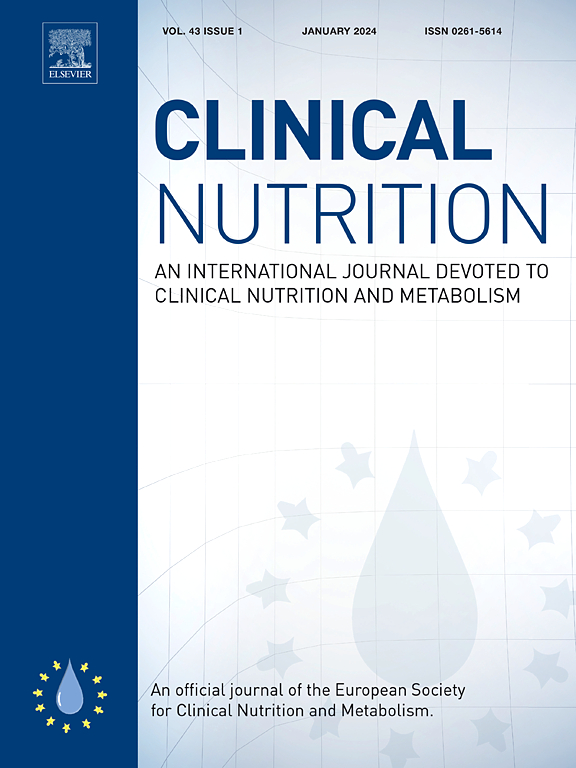Nutritional intake as a determinant of high-speed resistance and multicomponent training efficacy on strength in older women at risk of sarcopenia. A randomized clinical trial
IF 6.6
2区 医学
Q1 NUTRITION & DIETETICS
引用次数: 0
Abstract
Background and aim
Despite advances in research on training and nutritional supplementation, it is largely unknown how micronutrient intake modulates the response to training in older adults. This study investigates the relationship between nutrient intake and response to training in older women at risk of sarcopenia.
Methods
A randomized clinical trial with two parallel groups (high-speed resistance training (H-RT) and multicomponent training (MT)) was conducted over a 32-week intervention involving 80 older women at risk of sarcopenia (mean age: 77.36 ± 6.71 years). A food frequency questionnaire was administered to assess whether nutrient intake influenced strength outcomes measured by the Five Times Sit-to-Stand Test (5STS) and other functional variables.
Results
Significant improvements in the five times sit to stand test (5STS) were observed in both groups post-intervention (p < 0.001), with no significant differences between them (p = 0.127), suggesting comparable effectiveness. In both groups, lower levels of vitamin B12 (H-RT: rp = −0.52; MT: rp = −0.50) and vitamin D (H-RT: rp = −0.55; MT: rp = −0.69) were associated with worse 5STS performance. Additionally, in the H-RT group, lower levels of vitamin E (rp = −0.36), magnesium (rp = −0.48), iron (rp = −0.43), and potassium (rp = −0.47) were also correlated with poorer performance.
Conclusions
The results indicate that improvements in strength are related to micronutrient sufficiency rather than macronutrient sufficiency. Deficiencies in vitamin D and B12 negatively impacted muscle strength gains in both H-RT and MT, while vitamin E, potassium, magnesium, and iron influenced H-RT outcomes. The lesser effect of micronutrient deficiencies on MT suggests it may be more suitable for individuals with mild deficiencies, as it requires fewer specific nutrients for muscle strength.
Registration
The study is registered at ClinicalTrials.gov under the identifier NCT05870046.
营养摄入作为高速阻力和多组分训练对老年妇女肌肉减少风险力量的决定因素。一项随机临床试验
背景和目的尽管在训练和营养补充方面的研究取得了进展,但微量营养素摄入如何调节老年人对训练的反应在很大程度上是未知的。本研究调查了营养摄入与老年妇女肌肉减少症风险的训练反应之间的关系。方法采用两组(高速阻力训练组(H-RT)和多组分训练组(MT))进行随机临床试验,对80例有肌肉减少症危险的老年妇女(平均年龄:77.36±6.71岁)进行为期32周的干预。使用食物频率问卷来评估营养摄入是否会影响五次坐立测试(5STS)和其他功能变量测量的力量结果。结果干预后两组患者5次坐立测试(5STS)均有显著改善(p <;0.001),两组间无显著差异(p = 0.127),提示疗效相当。在两组中,维生素B12水平较低(H-RT: rp = - 0.52;MT: rp = - 0.50)和维生素D (H-RT: rp = - 0.55;MT: rp = - 0.69)与较差的5STS表现相关。此外,在H-RT组中,较低水平的维生素E (rp = - 0.36)、镁(rp = - 0.48)、铁(rp = - 0.43)和钾(rp = - 0.47)也与较差的表现有关。结论体力的提高与微量营养素的补充有关,而与大量营养素的补充无关。缺乏维生素D和B12会对H-RT和MT的肌肉力量增加产生负面影响,而维生素E、钾、镁和铁会影响H-RT的结果。微量营养素缺乏对MT的影响较小,这表明它可能更适合轻度缺乏的个体,因为它需要更少的特定营养素来维持肌肉力量。该研究已在ClinicalTrials.gov注册,识别码为NCT05870046。
本文章由计算机程序翻译,如有差异,请以英文原文为准。
求助全文
约1分钟内获得全文
求助全文
来源期刊

Clinical nutrition
医学-营养学
CiteScore
14.10
自引率
6.30%
发文量
356
审稿时长
28 days
期刊介绍:
Clinical Nutrition, the official journal of ESPEN, The European Society for Clinical Nutrition and Metabolism, is an international journal providing essential scientific information on nutritional and metabolic care and the relationship between nutrition and disease both in the setting of basic science and clinical practice. Published bi-monthly, each issue combines original articles and reviews providing an invaluable reference for any specialist concerned with these fields.
 求助内容:
求助内容: 应助结果提醒方式:
应助结果提醒方式:


